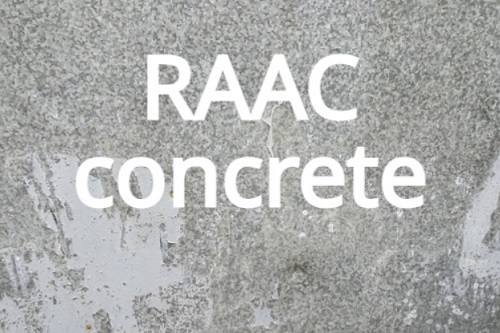Concerned about crumbling concrete?

Authored by Allianz
Reinforced Autoclaved Aerated Concrete (RAAC) has made the headlines recently for all the wrong reasons. This is due to concerns about the risk of sudden collapse in schools and other buildings where the material is used.
What is RAAC?
RAAC is a lightweight form of concrete, commonly used in construction between the 1950s and mid-1990s. It’s predominantly found in precast panels in roofs (commonly flat roofs, but sometimes pitched) and occasionally in floors and walls.
RAAC has been a widely used building material because it’s cheap, lightweight and provides good thermal insulation. RAAC panels are typically light grey or white in appearance, and the underside of the panels will generally appear smooth. Inside the panels are bubbly, bearing some resemblance to an aerated chocolate bar.
Why is RAAC a potential risk?
Unfortunately RAAC’s lightweight properties come at a cost to its structural strength. Due to its highly porous nature, it is significantly more prone to cracks and weaknesses.
RAAC is present in some buildings despite it being well over its expected lifespan of 30 years. Roofs built with RAAC have been known to collapse suddenly, including cases where the panels appeared to be in good condition.
In late 2018, the Local Government Association (LGA) and the Department for Education (DfE) contacted all school building owners to draw attention to a recent failure involving a flat roof constructed using RAAC panels.
In May 2019 the Standing Committee on Structural Safety (SCOSS) issued an alert to highlight the potential risks from RAAC.
Since then, sudden collapses in RAAC panels in roofs continue to be reported. Guidance was issued by the Department for Education, requiring responsible bodies within the education sector to identify RAAC in their estates.
Where was RAAC used?
Whilst the recent news coverage focuses on RAAC in schools, the scale of its use is much wider and across both the public and private sector. RAAC has been identified in hospitals, theatres, airports, residential buildings, universities, shopping centres, police stations and court buildings.
What do building owners need to do?
Due to the limited durability and known issues, it is essential that building owners and/or the responsible persons take steps to confirm the safety of any RAAC in their premises.
If RAAC is identified or suspected, guidance should be sought from an appropriately qualified building surveyor or structural engineer with experience of RAAC.
The initial task of the surveyor or engineer is to confirm if RAAC is present in the premises, subsequently determining its condition and required remedial action, which may include replacement.
As Allianz policies contain a standard market exclusion in respect of Buildings, where there is destruction or damage to any building or structure caused by its own collapse or cracking, it is important that professional guidance is sought to address any issues associated with the presence of RAAC.
Wherever RAAC has been identified, customers should contact their broker for guidance and to fulfil a duty to disclose material information.
Appointing a building surveyor and/or structural engineer
To ensure that the building surveyor and/or structural engineer has the appropriate qualifications and experience, the government guidance suggests the following credentials:
Building surveyor
relevant degree e.g., BSc (Hons) Building Surveying3 years relevant experience assessing building condition, this can be measured in the time elapsed since completion of an appropriate industry related degree or qualification, e.g. BSc (Hons) Building Surveyingevidence of one-year minimum relevant RAAC project / commission experiencemembership of Royal Institution of Chartered Surveyors with Building Surveyor designation (not essential).
Structural engineer
Chartered Membership of the Institution of Structural Engineers (CEng MIStructE), and/orChartered Membership of the Institution of Civil Engineers (CEng MICE).
Evidence of experience of the following:
surveying, assessment and design/specification of remediation works to existing buildingsvisual inspection works and desk-study workphysical inspection works, either specification and management or physical worksmanagement and post-completion evaluation of remedial works constructionRAAC experience is essential.
More guidance on appointing an appropriately qualified building surveyor or structural engineer can be found at gov.uk – Reinforced Autoclaved Aerated Concrete (RAAC): Identification guidance.
Where remedial action is needed, we’re usually able to offer existing Allianz customers a Contract Works policy to cover the additional building works – these types of covers neatly complement an existing Allianz policy which continues to cover the buildings.
If as a result of remediation or repair works, any buildings are going to be unoccupied and not in active use by a customer or their tenants for more than 30 consecutive days, customers should notify their broker.
Any concerns or queries about the extent of cover can also be discussed with their broker.
What about other concrete products?
It’s important to recognise that some of the challenges associated with RAAC and other concrete variants such as Autoclaved Aerated Concrete (AAC) and High Alumina Cement (HAC) are not new.
If an organisation has questions or doubts relating to the performance of any materials used in the construction of its premises or buildings, guidance from an appropriately qualified building surveyor and structural engineer is clearly critical.
And what about asbestos?
It’s also worth highlighting the potential for investigation, assessment, and remediation work relating to RAAC to present an increased exposure to asbestos, given that they may both be present in the same areas.
It’s key that the dangers posed by asbestos and asbestos containing materials are appropriately assessed in accordance with Health and Safety Executive (HSE) guidance and the requirements of the Control of Asbestos Regulations 2012





